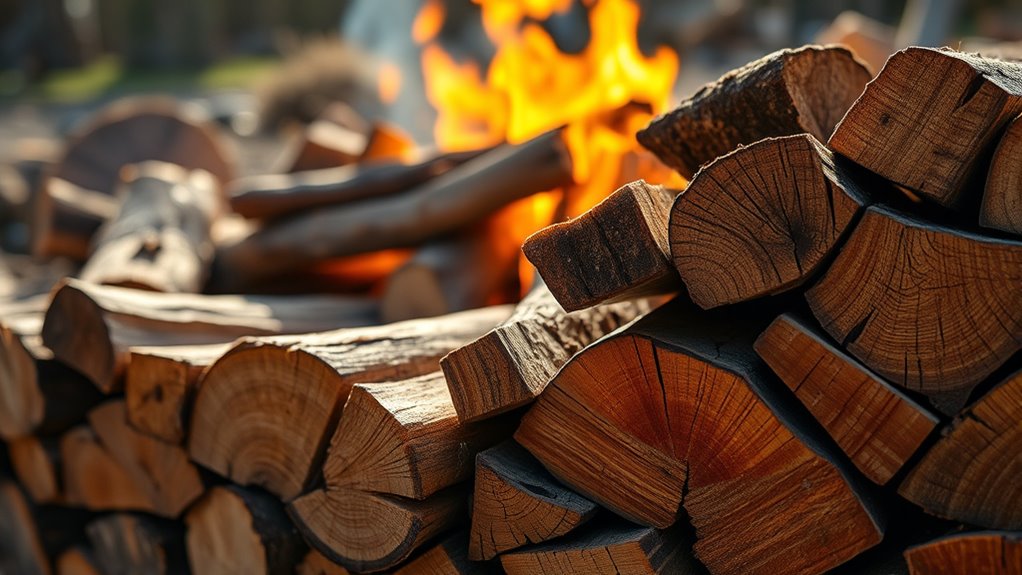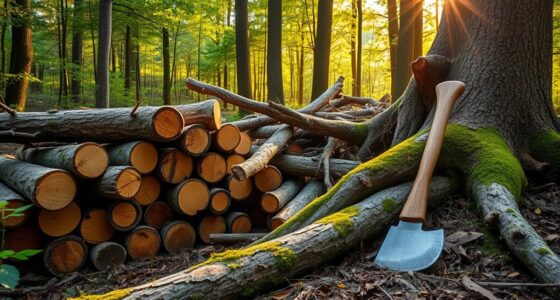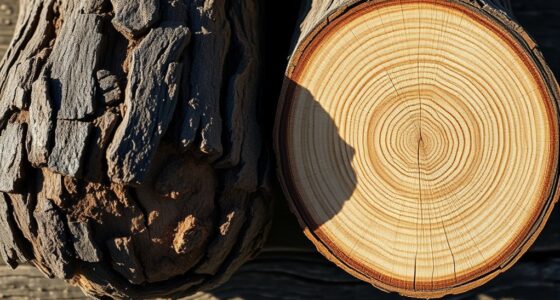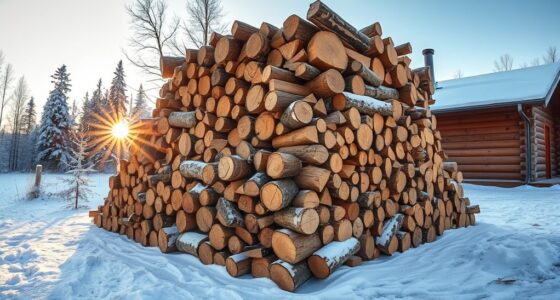Understanding BTU ratings helps you determine how much heat your firewood will produce, so you can choose the most efficient wood for heating. These ratings measure the energy content based on combustion, influenced by factors like moisture and wood density. Dry, dense hardwoods typically have higher BTUs, meaning more heat and longer burns. Knowing these details allows you to optimize your firewood selection for better warmth and efficiency—if you keep exploring, you’ll gain even more useful insights.
Key Takeaways
- BTU ratings quantify the heat energy produced during combustion, helping compare firewood’s heating efficiency.
- Well-seasoned, low-moisture wood delivers higher BTU output and cleaner burns.
- Denser hardwoods generally have higher BTU ratings due to greater energy content per volume.
- Moisture content significantly reduces heat output and causes more smoke and creosote buildup.
- Understanding these factors enables selecting firewood that burns hotter, longer, and more efficiently.
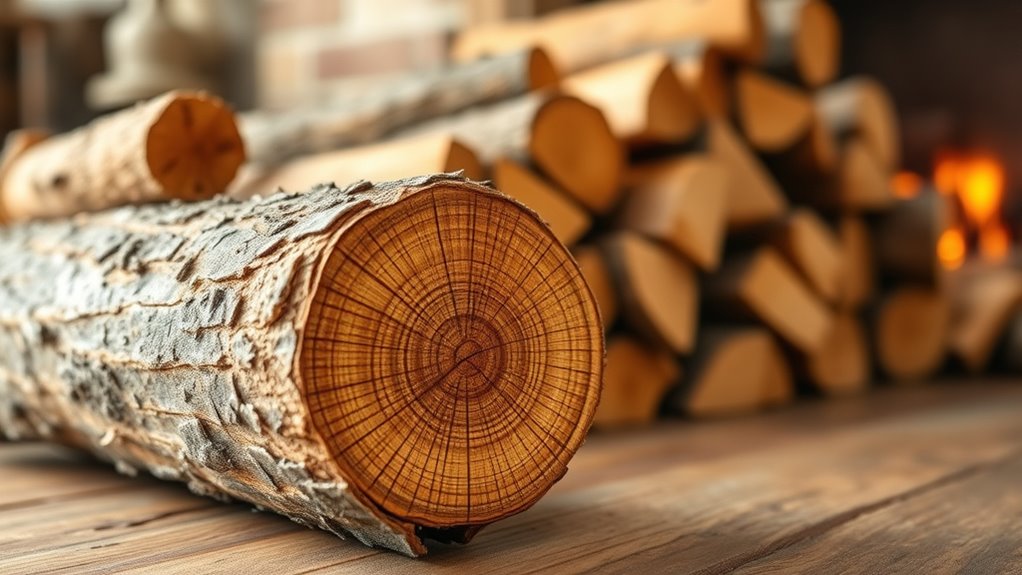
If you’re shopping for heating or cooling appliances, understanding BTU ratings is essential. When it comes to firewood, these ratings help you gauge how much heat you’ll get from burning a specific piece. But to truly grasp how firewood produces heat, you need to consider factors like moisture content and wood density. Moisture content refers to how much water remains in the wood, which directly impacts its heat output. The wetter the wood, the more energy is used to evaporate the moisture, which reduces the heat that actually reaches your living space. Well-seasoned firewood, with a moisture content below 20%, burns more efficiently and produces higher BTU ratings. On the other hand, green or unseasoned wood, which can have moisture levels over 40%, will burn sluggishly, produce more smoke, and deliver less heat.
Wood density also plays a critical role in determining the heat output of your firewood. Denser woods, like oak or hickory, contain more mass packed into each log, which means they have a higher energy content per unit of volume. This translates into higher BTU ratings because more energy is stored in each piece of dense wood. Less dense woods, such as pine or cedar, have lower wood density, so they produce less heat per log and tend to burn faster. Choosing wood with higher density not only gives you more heat but also results in longer-lasting fires, making your heating more efficient.
Understanding how moisture content and wood density influence BTU ratings helps you select the best firewood for your needs. When shopping or preparing firewood, look for seasoned logs with low moisture levels to maximize heat output. Consider the type of wood, especially if you’re aiming for longer-lasting fires; denser hardwoods usually provide more consistent and powerful heat. Keep in mind that properly stored firewood, kept off the ground and covered from rain, maintains its moisture content and wood density, ensuring ideal burn performance over time. By paying attention to these factors, you’ll not only improve your fire’s efficiency but also reduce smoke and creosote buildup, which can cause chimney problems. Ultimately, understanding the relationship between moisture content, wood density, and BTU ratings empowers you to make smarter choices, so your fires burn hotter, cleaner, and more efficiently.
Frequently Asked Questions
How Does Moisture Content Affect BTU Ratings?
Moisture content considerably impacts BTU ratings because wetter wood has lower heat output. When you burn moist wood, the moisture impact requires energy to evaporate the water, which reduces the overall heat you get. Proper wood drying increases BTU ratings, giving you more heat and efficiency. So, always aim for well-dried, seasoned wood to maximize heat output and get the best value from your firewood.
Do Different Wood Species Have Significantly Different BTU Outputs?
Yes, different wood species have markedly different BTU outputs due to variations in wood density and combustion efficiency. Denser woods like oak or hickory produce higher BTUs, offering more heat per cord. Softer woods like pine burn faster but generate fewer BTUs. Knowing these differences helps you choose the right wood for ideal heat output, ensuring your fire is efficient and effective for your heating needs.
How Accurate Are BTU Ratings in Real-World Heating Scenarios?
Did you know that BTU ratings can vary by up to 15% in real-world use? They’re a useful guideline, but actual heat output depends on your fireplace efficiency and how well your heating system matches the firewood’s BTU content. Factors like moisture, wood type, and burning conditions influence accuracy. To get consistent warmth, guarantee your setup is compatible with the firewood’s heat potential.
Can BTU Ratings Predict Burn Time for Firewood?
BTU ratings can help predict firewood efficiency and heating duration, but they aren’t exact. Higher BTU-rated firewood generally burns longer and produces more heat, giving you a rough idea of burn time. However, factors like wood moisture, size, and type influence actual burn duration. So, while BTU ratings are useful, they shouldn’t be solely relied upon for precise predictions of how long your firewood will last.
How Do Seasoned and Kiln-Dried Woods Compare in BTU Output?
Seasoned and kiln-dried woods pack a punch in BTU output, but kiln-dried wood often delivers even more power. With lower moisture content, kiln-dried wood burns hotter and cleaner, making it more efficient. Proper wood seasoning reduces moisture, ensuring consistent heat. If you want maximum heat from your firewood, kiln-dried options are like a rocket launch compared to seasoned wood, giving you a blazing, long-lasting fire every time.
Conclusion
By understanding BTU ratings, you can choose the right firewood for your heating needs. For example, if you need to warm a large room, selecting hardwood like oak with high BTU output guarantees efficient heat. Remember, knowing the energy content helps you save money and stay comfortable during winter. So, always check the BTU ratings before buying firewood, and you’ll enjoy a cozy, cost-effective fire every time.

